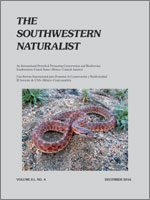We characterized the species richness, diversity, and distribution of amphibians and reptiles inhabiting El Monte Valley, a heavily disturbed, alluvium-filled basin within the lower San Diego River in Lakeside, California. This rare habitat type in coastal southern California is designated as a critical sand resource by the state of California and is currently under consideration for a large-scale sand mining operation with subsequent habitat restoration. We conducted field surveys from June 2015 to May 2016 using drift fence lines with funnel traps, coverboard arrays, walking transects, and road driving. We recorded 1,208 total captures, revealing high species richness and diversity, but with marked unevenness in species' abundances. Snakes were the most species-rich taxonomic group (13 species representing 11 genera), followed by lizards (11 species representing 9 genera). After the southern Pacific rattlesnake (Crotalus oreganus helleri), the California glossy snake (Arizona elegans occidentalis) was the second most frequently detected snake species (n = 23 captures). Amphibian species richness was limited to only three species in three genera. Despite the relatively limited 12-month sampling period, a longstanding drought, and severe habitat disturbance, our study demonstrates that El Monte Valley harbors a rich herpetofauna that includes many sensitive species.
How to translate text using browser tools
1 December 2016
Rare alluvial sands of El Monte Valley, California (San Diego County), support high herpetofaunal species richness and diversity, despite severe habitat disturbance
Jonathan Q. Richmond,
Carlton J. Rochester,
Nathan W. Smith,
Jeffrey A. Nordland,
Robert N. Fisher
ACCESS THE FULL ARTICLE

The Southwestern Naturalist
Vol. 61 • No. 4
December 2016
Vol. 61 • No. 4
December 2016




